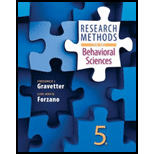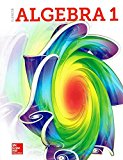
Research Methods for the Behavioral Sciences (MindTap Course List)
5th Edition
ISBN: 9781305104136
Author: Frederick J Gravetter, Lori-Ann B. Forzano
Publisher: Wadsworth Publishing
expand_more
expand_more
format_list_bulleted
Concept explainers
Textbook Question
thumb_up100%
Chapter 8, Problem 2EA
A recent survey at a major corporation found that employees who regularly participated in the company fitness program tended to have fewer sick days than employees who did not participate. However, because the study was not a true experiment, you cannot conclude that regular exercise causes employees to have fewer sick days.
- Identify another factor (a confounding variable) that might explain why some employees participated in the fitness program, and why those same employees have fewer sick days.
- Describe how the factor you identified in Part a is controlled in your experiment.
Expert Solution & Answer
Trending nowThis is a popular solution!

Students have asked these similar questions
An experimenter is interested in the effects of two independent variables onself-esteem. What is better about conducting a factorial experiment thanconducting two separate experiments, one for each independent variable?
Knight and Haslam (2010) found that office workers who had some input into the design of their office space were more productive and had higher well-being compared to workers for whom the office design was completely controlled by an office manager. For this study, identify the independent variable and the dependent variable
A researcher is interested in examining whether doctors are as accurate at diagnosing certain illnesses via telehealth as they are in person. She randomly assigns a sample of doctors to either see patients via telehealth or in person, and assesses their diagnostic accuracy.
What is the dependent variable?
Chapter 8 Solutions
Research Methods for the Behavioral Sciences (MindTap Course List)
Ch. 8.1 - Describe, compare, and contrast the defining...Ch. 8.1 - Explain the general advantages and disadvantages...Ch. 8.2 - Define individual differences and explain how...Ch. 8.3 - Identify the three primary techniques for limiting...Ch. 8.4 - Describe how individual differences influence...Ch. 8.4 - Identify the options for reducing or controlling...Ch. 8.5 - Describe how differential attrition and...Ch. 8.6 - Describe how between-subjects designs are used to...Ch. 8 - In addition to the key words, you should also be...Ch. 8 - Identify the basic features of a between-subjects...
Ch. 8 - In a between-subjects design, each individual...Ch. 8 - Briefly explain how a participant characteristic,...Ch. 8 - Briefly explain how random assignment attempts to...Ch. 8 - Explain the advantages and disadvantages of using...Ch. 8 - Briefly explain why large variance within...Ch. 8 - Explain how holding a participant variable such as...Ch. 8 - Explain how holding a participant variable such as...Ch. 8 - Describe some of the problems that can arise when...Ch. 8 - Describe the advantages of a two-group design...Ch. 8 - A researcher has a sample of 30 rats that are all...Ch. 8 - A recent survey at a major corporation found that...
Knowledge Booster
Learn more about
Need a deep-dive on the concept behind this application? Look no further. Learn more about this topic, statistics and related others by exploring similar questions and additional content below.Similar questions
- Night and Haslam 2010 found that office workers who had some input into the design of their office space were more productive and had higher well being compared to workers for whom the office designs was completely controlled by an office manager for this study identifying the independent variable and the dependent variablearrow_forwardThe director of an obesity clinic in a large northwestern city believes that drinking soft drinks contribute to obesity in children. To determine whether a relationship exists between these two variables, she conducts the following pilot study. Eight- 12-year-old male volunteers are randomly selected from children attending a local junior high school. Parents of the children are asked to monitor the number of soft drinks consumed by their child over a one week period. The children are weighed at the end of the week and their weights converted into body mass index (BMI) values. The BMI is a common index used to measure obesity and takes into account both height and weight. An individual is considered obese if they have a BMI value 30. The following data or collected: child. # of soft drinks consumed BMI 1 3 20 2 1 18 3…arrow_forwardA well-known study of 22,000 male physicians was conducted to determine if taking aspirin daily reduces the chances of a heart attack. Half of the physicians were given a regular dose of aspirin while the other half was given placebos. Six years later, among those who took aspirin, 104 suffered heart attacks while among those who took placebos, 189 suffered heart attacks. Does it appear that the aspirin can reduce the number of heart attacks among the sample group that took aspirin? Use α = 0.05.arrow_forward
- Katrina Bell, analyst for the Hexaco Oil Company, has been assigned the task of investigating the claim that Hexaco dealers charge more for unleaded gasoline than do independent dealers. Katrina is afraid that if she chooses two independent random samples of stations for each type of dealer, the variability in price due to geographic location might be a factor. To eliminate this source of variability, she chooses a pair of stations : one independent and one Hexaco in close geographic proximity of each region. The results of the sampling are in Sheet 47. What should Katrina conclude at the 0.01 significance level? Hexaco Independent 90,5 89,9 91,9 90,9 92,7 90,9 91,9 90,9 93,6 91,8 89,9 90,9 90,9 90,9 89,8 88,9 88,7 88,9 87,9 88,6 92,7 91,9 Select one:…arrow_forwardA researcher hypothesizes that the lowering in cholesterol associated with weight loss is really due to exercise. To test this, the researcher carefully controls for exercise while comparing the cholesterol levels of a group of subjects who lose weight by dieting with a control group that does not diet. The difference between groups in cholesterol is not significant. Can the researcher claim that weight loss has no effect?arrow_forwardA researcher is examining the effects of weight status and hunger on eating behavior. In this 2 X 2 factor study, participants (obese vs. normal weight) are randomly assigned to participate in one of two hunger status conditions (full stomach vs. empty stomach). Then during the study, participants are presented with crackers to eat. The researcher is looking to see if weight status, hunger status and an interaction between the two influence eating behavior. Considering this data, what would be the statistical and null hypothesis for the main effect for weight status? Select one: a. H1: μobese = μnormal weight Ho: μobese ≠ μnormal weight b. H1: μfull stomach ≠ μempty stomach Ho: μfull stomach = μempty stomach c. H1: μfull stomach = μempty stomach, Ho: μfull stomach ≠ μempty stomach d. H1: μobese ≠ μnormal weight Ho: μobese = μnormal weightarrow_forward
- A coffee company uses a data-based approach to improving the quality and customer satisfaction of its products. When survey data indicated that the coffee company needed to improve its package-sealing process, an experiment was conducted to determine the factors in the bag-sealing equipment that might be affecting the ease of opening the bag without tearing the inner liner of the bag. One factor that could affect the rating of the ability of the bag to resist tears was the plate gap on the bag-sealing equipment. Data were collected on 19 bags in which the plate gap was varied. 1) Assuming a linear relationship, use the least-squares method to find the regression coefficients b0 and b1. 2) Interpret the meaning of the slope, b1, in this problem. Choose the correct answer below. A. For each increase of one in the tear rating, the plate gap is expected to increase by b1 units. B. The approximate tear rating when the plate gap is 0 units is b1. C. The…arrow_forwardA coffee company uses a data-based approach to improving the quality and customer satisfaction of its products. When survey data indicated that the coffee company needed to improve its package-sealing process, an experiment was conducted to determine the factors in the bag-sealing equipment that might be affecting the ease of opening the bag without tearing the inner liner of the bag. One factor that could affect the rating of the ability of the bag to resist tears was the plate gap on the bag-sealing equipment. Data were collected on 19 bags in which the plate gap was varied. A) Assuming a linear relationship, use the least-squares method to find the regression coefficients b0 and b1. Interpret the meaning of the slope, b1,in this problem. Choose the correct answer below. A.For each increase of one in the tear rating, the plate gap is expected to increase by b1 units. B. The approximate tear rating when the plate gap is 0 units is b1. C. The approximate…arrow_forwardA consumer advocacy group wanted to study whether different airline carriers differed in terms of their delayed flights. In particular, the researchers were interested in the relationship between p1, the proportion of Alpha Airlines flights that were delayed at least 15 minutes, and p2, the proportion of Beta Airlines flights that were delayed at least 15 minutes. A random sample of 1,000 Alpha flights and a separate random sample of 1,000 Beta flights found that 67 of the Alpha fights and 160 of the Beta flights were delayed at least 15 minutes. The conditions for inference were checked and verified. Does this set of samples provide strong evidence that Alpha Airlines has a smaller proportion of flights that are delayed at least 15 minutes than Beta Airlines, at the α = 0.05 significance level? Find the z-table here. A. The test statistic is z = –6.56 and the P-value ≈ 0. Since the P-value ≈ 0 < 0.05, there is not sufficient evidence that Alpha Airlines has fewer delayed…arrow_forward
- In reading the results of a multiple regression analysis that contained 4 predictor variables, the researcher noticed a column labeled Beta. Two of the Beta’s were positive and two were negative. He concluded that a.) Beta’s that were positive were statistically significant b.) Beta’s that were positive had more of an effect c.) Beta’s that were positive were associated with increases in the criterion variable d.) Beta’s that were positive did not affect the criterion because they were “controlled for…”arrow_forwardIf the results of a two-factor ANOVA show no main effect for factor A but show a significant interaction, then the results indicate that factor A has no effect on the subjects' scores. True or Falsearrow_forwardIn a two-way ANOVA, the main effect of a factor is the A. extent to which the factor produces dependent variable scores different from those the other factor produced. B. effect that changing the levels of the factor has on the dependent variable, taking into account all other factors in the study. C. effect that changing the levels of the factor has on the dependent variable, ignoring all other factors in the study. D. extent to which its effect depends on the other factor.arrow_forward
arrow_back_ios
SEE MORE QUESTIONS
arrow_forward_ios
Recommended textbooks for you
 Big Ideas Math A Bridge To Success Algebra 1: Stu...AlgebraISBN:9781680331141Author:HOUGHTON MIFFLIN HARCOURTPublisher:Houghton Mifflin Harcourt
Big Ideas Math A Bridge To Success Algebra 1: Stu...AlgebraISBN:9781680331141Author:HOUGHTON MIFFLIN HARCOURTPublisher:Houghton Mifflin Harcourt Glencoe Algebra 1, Student Edition, 9780079039897...AlgebraISBN:9780079039897Author:CarterPublisher:McGraw Hill
Glencoe Algebra 1, Student Edition, 9780079039897...AlgebraISBN:9780079039897Author:CarterPublisher:McGraw Hill

Big Ideas Math A Bridge To Success Algebra 1: Stu...
Algebra
ISBN:9781680331141
Author:HOUGHTON MIFFLIN HARCOURT
Publisher:Houghton Mifflin Harcourt

Glencoe Algebra 1, Student Edition, 9780079039897...
Algebra
ISBN:9780079039897
Author:Carter
Publisher:McGraw Hill
Sampling Methods and Bias with Surveys: Crash Course Statistics #10; Author: CrashCourse;https://www.youtube.com/watch?v=Rf-fIpB4D50;License: Standard YouTube License, CC-BY
Statistics: Sampling Methods; Author: Mathispower4u;https://www.youtube.com/watch?v=s6ApdTvgvOs;License: Standard YouTube License, CC-BY